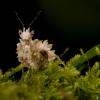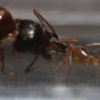For best results, ask the ants outside. Seriously.
There is a lot of variation in behavior even within ants of the same species, based almost entirely upon their location and the microclimate each colony experiences. Assuming you collected a species nearby, if a wild colony of it is inactive based upon the weather your area is experiencing, chances are yours should be to.
Prenolepis imparis is indeed an interesting species. Or group of species, I should say, as this is a very wide ranging ant with high amounts of morphological variations based upon geography that likely points to there being multiple species currently under the guise of a single one. Taxonomically speaking, such a case is a common occurrence for many ants where the effort has yet to be made to painstakingly separate them.
As for your question, this species doesn’t hibernate per say in regards to most of the temperate ants commonly kept. They’ve evolved to occupy the empty niche left in the wake of other species whom retire during cold weather. This means that in many areas they’re “active” during the cool temperatures between late Fall and early Spring - a period when most would hibernate their captive ants. But due to their normally deep nests, they likely never experience temperature extremes on the surface, and the colony itself undoubtedly exists in a rather stable environment year round, at least in some parts of their range. Nests in Florida have measured in at more than 9 feet deep! They do, however, require cold temperatures to forage. In Massachusetts and Missouri, their preferred foraging temperature is from 35 to 55 degrees, though activity occasionally takes place as low as 26 degrees to slightly above 60. If temperatures are too low, they’ll probably retreat to the nest and wait it out, but will be back at it as soon as the weather eases its grip.
Here in Central Florida, one of their most southernly occurrences, I’ve observed foraging in temperatures as high as 80 degrees in the shade, and it of course never gets cold enough here to halt their search for food. Activity typically takes place starting in November and lasting till April. In their more northerly ranges, colonies may be active above ground for most of the year except during the hottest parts.
Normally, after a season(s) spent foraging, they exhibit their bloated corpulent state from which they derived their namesake. It is this store of food from which the first and only brood is produced every year during the period when their above ground activity ceases. As only one batch of workers is produced a year, growth is painfully slow, though keeping polygynous colonies may help offset this. Some nests have been excavated with over a dozen queens.
How all these behavioral and morphological adaptions translate into their proper care in captivity is a very good question. Fact remains that while this is a very common species with a predictable flight period and conspicuous queens (lots of people keep them) hardly anyone has succeeded in rearing a colony past its first few years. Two likely reasons may explain why. One may be that few colonies are provided with proper temperatures and seasonal variations to accommodate their highly cyclical lifestyle, thereby reducing brood production, queen and worker health, and food receptivity. And two, their very slow growth rate means that most people lose interest in them before they reach any appreciable numbers.
Edited by 123LordOfAnts123, December 10 2017 - 5:05 PM.



















